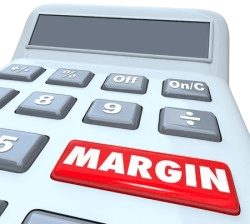
Margin. I know, sounds pretty boring. But with a little explanation, margin is one of the most important statistics in our business and personal life. Margin is defined as “the amount by which something is won or lost” or also as “the edge or border of something.”
The first and most important use of margin for business purposes is with “Gross” in front of it. We’ve all heard of Gross Profit; Gross Margin is usually expressed as a percentage while Gross Profit is shown as dollars. We often tell our clients that Gross Profit/Margin is one of, if not the most important metric to track business performance. Not hitting the desired margin means we can say good-bye to any bottom line profits.
Which leads us to the next use of the word margin. Profit margin is similar to Gross Margin, a percentage showing what portion of revenue is profit. Everyone focuses on profitability, which is the logical choice for a beginner. Experienced entrepreneurs and managers know that managing to profit margin is like shutting the barn door after the cows are out.
Here is an example using hard numbers to illustrate how understanding margin may affect business strategy:
ACME Co has 3 different lines of business. Below is the revenue and gross profit for each:
- X: $1.4 million or 70% of the total — $160,000 profit (11.4%)
- Y: $0.3 million or 15% of the total — $20,000 loss
- Z: $0.3 million or 15% of the total — $60,000 profit (20%)
Total: $2.0 million revenue, $200,000 profit
While Service X is generating the most dollar profit for the business, it’s actually Service Z that’s the most profitable (highest margin). So, service Z generates the most return. And, Service Y may need to be discontinued or turned around.
Optimizing Profits
Your strategy for a more optimum revenue mix might be to sell as much of Service Z as possible, while eliminating or fixing the problem around Service Y. But remember to consider other factors for optimizing profits, such as:
- Products/services positioned for growth due to market conditions
- Products/services that are loss leaders for other products/services
- Adjusting prices to increase profit margins
As described above, if a business doesn’t hit the Gross Margin targeted, it’s very hard if not impossible to cut enough expenses to achieve the Profit Margin goals. Regardless, after ensuring the gross margin is right, the logical next step is profit margin. This will ensure the overhead or administrative expenses aren’t excessive and chewing up the gross profits.
Finally, we come to maybe the best use of margin, the idea of a “cushion” or “space.” Most entrepreneur clients have more demands on their time then they can handle and every day is a juggling act to keep all the plates in the air. Spend some time thinking about what you like to do, and put the activity on your calendar. It may take that kind of discipline to make sure that you get time for yourself. But the result will be worth it. You just might find that the extra down time makes the rest of the margins go up.
Inertia is a powerful force, whether it’s just resolving to make changes or actually doing something about it. So, here’s permission to take the pressure off with a twist on the whole resolution situation. Choosing a word of the year – and sticking with it – may be easier than making a list of New Year’s resolutions. Margin is a great place to start. We would love to hear about other words that are important to you.
Happy 2016!


